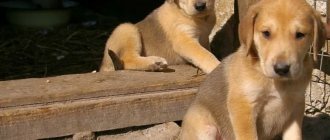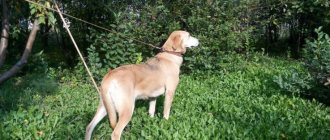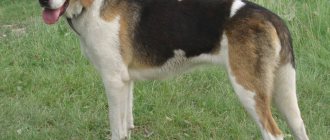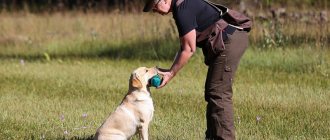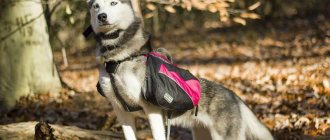The Russian Hunting Spaniel (ROS) is the only national breed of gun dog. These are loyal, flexible and friendly animals. They love an active life and always strive to show their hunting qualities. Therefore, when training Russian hunting spaniels, it is important to take this feature into account, even if the owner is not a fan of hunting.
Character and behavior
Hunting spaniels have all the necessary qualities that allow them to be excellent hunters. These dogs are persistent, have excellent sense of smell and are easy to train.
Animals are ready to carry out commands not only of the owner, but also of any other person on the hunt who has a gun in his hands.
Russian hunting spaniels are bred not only for hunting. Such dogs turn out to be excellent companions for all family members. They are active and enjoy playing with children or going hiking with adults. Animals by nature are good swimmers and will not miss the opportunity to splash around in the water.
The dog gets along well with other animals in the house. Spaniels easily get along in the same territory not only with other dogs, but also with cats. However, it is not recommended to keep your dog with small pets, such as hamsters or guinea pigs. There is a high probability that the spaniel may succumb to the hunting instinct. If desired, the ward can develop guard qualities.
However, it is believed that if a dog is used as a guard, its hunting characteristics will deteriorate significantly.
Learning to “Sit”
For the Russian spaniel, as well as the English one, this order is the most used in frequency. It's quite easy to learn. Holding a treat in one hand and lightly pressing on the croup with the other, forcing you to sit down, you must order “Sit!”
When the four-legged dog follows the command, you need to reward it with a piece of tasty food and a soft word. To achieve this, you can use a leash to hold and lightly pull back.
You can move your hand with the treat over your head a little back, tracking the object of interest to him, he will definitely sit down. Over time, they practice the command, gradually increasing the distance from the owner.
On a hunt, such a command is used if it is necessary to calm down a heated spaniel so that he does not react to the shots of other hunters and remains in place if this is not necessary.
As a rule, after completing a command, the owner gives a piece of treat as a reward, so the dog will sit, turning to him in anticipation of a reward.
At home, such a reaction is quite acceptable, but when hunting it is not advisable, since, most likely, at this time the spaniel should follow the game with its eyes, so it is better to reward it with affection and a kind word.
At what age should you start parenting?
Raising and training Russian hunting spaniels is a mandatory and responsible task. If you don't train your dog properly, it will grow up disobedient and may bother everyone with hyperactivity. It is recommended to start raising puppies as early as possible.
Young individuals respond better to commands and learn new information more easily.
Between 8 and 12 weeks of age, puppies begin to actively explore the world around them. They are curious and willingly study every new object, get acquainted with people and other animals, if there are any in the house. During this period, it is recommended to start teaching your pet the simplest commands. The puppy must begin to respect the authority of the owner and unquestioningly fulfill his demands. At this age, spaniels are usually trained to respond to at least 2 commands: “Come!” and “Place!”
Spaniel Club. All about spaniels.
From the first days of getting into a new family, the spaniel begins to learn how to live in a new environment. Raising a puppy begins from the moment it appears, and then you can get a faithful hunting comrade, a family member at home. Despite excellent hunting abilities, the dog will not learn to use them on its own.
The first days of a puppy. The sooner training begins and the sooner the puppy is close to its future owner, the better. Usually at 2 months of age the dog can be taken away from its mother. Incorrect behavior must be stopped immediately. The owner should communicate with the puppy as much as possible: feed, walk, play. He punishes him and treats him when necessary. In the first seven months of life, the puppy “imprints” on its owner. Afterwards, a trusting relationship is established for life. By adopting an older dog, the owner will never receive such devotion. Training begins with the puppy getting used to its name. He must understand that after the nickname the owner is going to contact him and give a command. In fact, the dog's name replaces the word "Attention" for him. They begin to accustom him to the name during games, pet the dog and repeat his name. The second command is “Place”. The puppy must know where he can rest in peace. They take him to his place to sleep and rest. When hunting, he will associate the bedding with the place after the appropriate command.
Proper training of a young Russian spaniel
The most necessary commands
When hunting, you will need the “No” command. It is also needed in everyday life. This is how the dog is called to order, what he is doing or intending to do is prohibited. When hunting, it is needed because it will prevent the dog from spooking the game ahead of time and will rush after it. Feeding time is used for training. The puppy, along with the team, is held at a bowl of food and allowed to eat only on the command “Take . He will very quickly learn to carry out such simple commands. They teach the puppy to “Sit” . This is one of the simplest commands. Using this command as an example, the puppy should understand that by performing certain actions you can get a treat. The command is accompanied by light pressure on the puppy's croup. When he sits down, he receives praise and a treat.
Later they begin teaching the commands “Come to me”, “Give” and “Look” . All of them will be needed for hunting. The principle of training is always the same - command, action and encouragement. The owner must develop the necessary conditioned reflexes. And of course, you need to have great patience and always be friendly. They punish violations and generously reward correct behavior.
We invite you to watch a video about How to properly train a young Russian spaniel...
General recommendations
During training, it is necessary to take into account the character and behavioral characteristics of the pet. Each animal has a number of characteristics that distinguish it from other individuals, and therefore requires an individual approach. When interacting with Russian hunting spaniels, it is equally harmful to show endless love and to be overly strict.
During training, the method of encouragement and approval is widely used. It consists in the fact that after each successfully completed command, you need to reward the dog with a small amount of your favorite treat, praise and stroke it. In addition to praise for obedient execution of commands, there should also be a system of punishments.
It is not recommended to resort to physical force when punishing a dog. It is better to try to explain the reason for dissatisfaction with words, slightly raising your voice. During training, you should be careful when addressing your pet and commands. It is impossible for an animal to react to its name in the same way as to the call “Come to me!” To do this, before each command it is necessary to pronounce the dog’s name, which will serve as a kind of signal.
What to pay attention to
The main thing for a puppy is to perceive his owner as a leader, to know him well and understand that he is his friend.
It has been established that the most favorable period for the formation of a lifelong impression of the owner in a dog’s memory is the first seven months of birth.
If your spaniel came to you at a more mature age, then you can quite count on obedience and devotion, but affection will still not be to the extent that the puppy is capable of.
Therefore, it is very important to take a small dog and give him a lot of attention.
Without enough time for training, it is better to postpone purchasing it, since for a Russian spaniel life “on the couch” will not be very joyful, because it is a hunter’s assistant.
It is advisable to give your four-legged friend a nickname and say it before giving other commands, just do not replace the order “Come to me!” with it.
The nickname should evoke pleasant associations of communication with you (play, walk, stroking). Be sure to arrange a place for your pet .
The best dimensions for a house are 50X60X50. Small puppies under two months of age sleep a lot and when you understand that the baby is full, has played and done all his business, order “Place!” or “Get in place!” At the same time, place it on the mat.
You can put a heating pad under it, which you remove immediately after waking up so that your pet doesn’t play with it.
Stroke and repeat the order for a while. It is permissible to pronounce an order by patting the mat, thus showing where to lie down. Later the order is executed without your additional movements.
Puppy training
The starting point for raising Russian Hunting Spaniel puppies can be considered their accustoming to their owner. This process begins from the very moment when the animal is separated from its mother and reaches a person. Training, by and large, comes down to the fact that the owner should be near the pet as often as possible.
Only the owner should feed, walk and play with the puppy. Thus, the animal will quickly become attached to one specific person, to whom in the future it will listen most of all. During this period, under no circumstances should you handle the spaniel roughly or shout at him. Otherwise, the animal’s psyche may be disturbed.
Command “Come to me!”
The feeding process is always good to use for training. So before eating, you need to call the puppy, then command “Come to me!”
It is important that food appears in his field of vision after executing the command. Kids also love to play with their owner when he is lying on the floor.
Before taking a horizontal position, order “Come to me!” Then it is not necessary to reward with treats; as a reward, the puppy will receive a lot of positive emotions from playing with you.
Together with this command, the dog is taught to act on the whistle.
On a hunt, when you need to call a spaniel that has run far away, he may not be able to hear his voice, then a whistle will help. First, use the whistle command at the same time, then alternate.
Content
Being a “city hunter” dog, the spaniel is adapted to both difficult field conditions (frost, strong wind, rain, heat) and to a small apartment.
The main requirement for his comfortable and happy life at home is:
- long daily walk (an hour and a half a day);
- proper feeding;
- coat care;
- taking care of the health of “problem” ears and eyes.
Feeding
The diet of a Russian spaniel must be balanced and contain all the necessary nutrients and elements.
Good for dogs:
- veal, chicken, chicken liver, boiled beef and chicken offal;
- boiled sea fish fillet;
- vegetables and fruits;
- premium feed.
Adult pets are fed twice a day. Puppies – 5-6 times a day in small portions, avoiding overfeeding.
Care
This breed does not require complex care: the dog must be combed regularly (at least 2-3 times a month), and bathed if necessary.
Taking care of your health
Dogs of this breed are strong, healthy animals.
The weak point is:
- Ears. The dog's long, floppy ears need to be checked and cleaned regularly due to the Spaniel's predisposition to ear infections. The puppy is taught to clean his ears from a very early age;
- Eyes. The eyes often get infected and conjunctivitis develops, so they need to be cleaned of dirt and, if there is watery eyes, rinsed with clean water.
General pet care requirements include: annual vaccination, treatment for parasites, fleas and ticks. Important! The spaniel should not be chained, kept outside in winter, or allowed to overheat or become hypothermic.
How to train a dog correctly?
When the spaniel is 3-4 months old, it must be trained to the “near” command. In addition, at this time it is time to teach your pet the commands “stop”, “show teeth”, “collar”. At this time, the baby understands the hours of meals if the owner feeds him on time. For education and training to be successful, several key rules must be taken into account.
- Everything has its time. If you shift upbringing and training from day to day, blaming everything on lack of time, you won’t be able to raise a dog.
- Regularity. It is necessary to train your pet every day so that the animal can consolidate its skills by learning the norms of behavior.
- Moderation of load . You cannot mix several commands at the beginning of training, as the pet will confuse their meaning.
- Patience. If the child follows the command correctly, he must be encouraged; if he cannot learn the lesson, you must not raise your voice at him or offend him with lack of attention.
- Game approach. Spaniels are cunning animals, and therefore they can quickly get bored with monotonous training. Without a creative approach, they will get bored and try to take the parenting initiative into their own hands.
- Personal contact. You should not delegate upbringing and training to someone else, because personal communication is the key to a trusting relationship between the dog owner and the pet itself.
Accustoming to water and swimming
At about six months, the puppy should already understand the command “bring it to me.” At this time, he is ready to learn to swim, for which the owner must choose a sunny day.
A small reservoir with sloping banks is suitable for this. In order not to scare the dog, you should not deliberately pull it into the water.
For the first time, you can use a wooden stick familiar to your pet.
It is thrown into the water so that it ends up in the water approximately one meter from the shore. Immediately the owner gives the command “give it”, but the stick should not be located where it will be deep. For the fact that the spaniel brings it, he is rewarded with affection or a treat. If the dog is not afraid of water, you can try to throw the stick a little further.
As a result, moving away from the shore over and over again in search of a stick, its paws will no longer reach the bottom, which will cause a swimming reaction. However, you should not torture your pet by constantly throwing a stick into the water: after several throws, it needs rest. If you don’t switch her attention to running or simply rolling in the grass, the workout will seem grueling to her, and therefore she’s unlikely to want to repeat this in the future.
Basic Commands
Training a spaniel involves following different commands. For example, a trained dog must understand not only its place, but also its name: it must be able to swim, walk next to its owner, sit or lie down at his request. In addition, the animal must have an understanding of the concepts of “slow motion” and “shuttle” search. He must have developed hunting skills, guard qualities and jumping.
A trained dog can go to the toilet outside from the age of four months. She is accustomed to a collar and leash and actively responds to the command “walk ”. the commands “give” and “sit” very well, as well as the command “seek”, which she readily learns due to the use of various treats for this.
In order for the owner to toilet train his pet faster, at first it is necessary to provide the puppy with a box of sawdust. This will reduce the puppy’s desire to relieve his needs anywhere.
In the future, you will need to take him outside more often, and walks should be frequent, but short. Over time, their duration increases and their number decreases.
The right start to training
Such training should begin with the awakening and identification of innate instincts that are given from birth. These include an interest in game and its search. It's easy to do. It is necessary to take the dog with you into the field and show wild birds. In addition, you can let the spaniel find the game itself and chase it. But here we must not allow ourselves to be carried away by such pursuits. If the dog has developed a passion for game, you need to restrain it; you should not always let it chase the birds.
In this case, the important point is not to restrain the dog earlier than expected. If she is forbidden to immediately chase birds, she will consider the command unconditional and will be afraid to approach the game. Sometimes a cowardly puppy gets banned and becomes completely unsuitable for hunting. This can be seen when he finds a bird and stops, but when he sees the hunter he immediately tucks his tail and leaves.
What kind of game to train a spaniel on?
In such cases, the best option is meadow and swamp game - great snipe, snipe and other birds located in the open where the dog can see them and the hunter can see them - the spaniel. There is no need to take a crake or crake for training when running fast. For a small puppy, this is a very exciting bird. When the dog grows up, he will have time to catch up with the birds, but at a young age the dog will definitely scare him and chase him, barking loudly. The hunter will stop him, but the mistake has already been made and will continue in the future, and the duration of the training will be extended.
Before training, do not forget about obedience lessons, even if done correctly, this will attract her to adherence to discipline. The simplest way is to come to an open place, leave the dog lying or sitting, then wave your hand and send it in the desired direction to hunt. This exercise is repeated up to three times. The hunter must stay close to the dog and periodically control the movement. If there is a lake, and the dog does not approach it, the hunter must set an example and walk along the shore of the lake. The dog will not run right away, but when he sees his owner leaving, he will follow him and overcome his fear to the swamp.
If it is clear that the dog has found the bird's trail, but cannot find the main trail, you need to call him back on the leash. It is necessary to control the dog's behavior. If a trace is discovered for her, you must immediately release her, and not allow her to stop on the fords, command “Search” for a long time. In this case, the behavior of the dog is important - a trace was found or he simply went in circles. You also need to know the behavior of birds; if the track is lost, the dog must be recalled. When a dog finds the trail of wild birds, it runs faster; it is important for the hunter to also quickly follow it. Usually dogs have a slight pull, they do not run fast, but they can be passionate. This must be stopped by pulling back or commands.
When the dog stops, the owner needs to be nearby and have time to stop him from quickly chasing the game.
Training methods
If you know the spaniel's temperament, you can understand whether the dog is stubborn or obedient. If stubbornness appears, you need to carry out training on a long cord, reaching a length of 40 meters. A noose is often used. A simple linen training cord, impregnated with wax to give strength. It does not get wet, is light in weight, and does not cling to swamp hummocks.
You can’t listen to the advice of those hunters who tie their dogs’ hind legs, or tie a stick to them, which hits their paws and prevents them from running. This is mockery and stupidity; any dog can be trained using simple methods. When the dog is chasing, you need to let it go a couple of meters, then command “no” and stop it by pulling the cord towards you. From such a command the dog lies down and experiences pain. The dog will remember such manipulations for the rest of its life, when the bird’s rutting caused it to hurt, and it sees the hunter’s prohibition.
When executing this command, the dog needs to be encouraged and given a treat so that it remembers what it did correctly. Training this behavior requires a lot of patience and time. This cannot be achieved in two training sessions.
Raising a 2 month old Cocker Spaniel puppy
At 2 months old, your American Cocker Spaniel puppy is still at home, in quarantine after the first vaccinations, and he is not yet allowed to go for walks. Therefore, it’s time to start raising a puppy in familiar home conditions.
The first step is teaching the puppy to go to the toilet in a diaper . At the same time, it should be remembered that any learning is a rather complex thing, and when you see the first positive results, you should not think that your puppy has already understood everything, but you should continue training according to the method, so that after a while you do not have to start all over again.
The second important point will be to accustom the puppy to a collar and leash . Yes, yes, this should be done at home, so that by the time the puppy goes outside for the first time, wearing a collar will not be additional stress for him, but is already a familiar thing, and he can begin to explore the world around him, rather than trying get rid of an unknown object.
The third point, which causes the greatest difficulties for new puppy owners, will be the definition of the puppy’s boundaries of what is permitted :
- Teach to play only with your toys, and not with your things;
- Explain that you cannot bite your hands even in a game;
- Establish the correct daily routine, establishing the rule that in the morning you need to sleep and not wake you up;
- Stop chewing furniture, clothes, walls and baseboards;
- Teach to stay home alone, knowing that your absence is not a reason to bark or howl.
"Give it to me!" and “Look!”
For a spaniel, one of their hunting instincts is to retrieve their prey, so you just need to master this skill.
Spaniels serve better from the water, but you can start working on it from the ground. The best option for serving would be wings from game feathers.
First, throw the wing and order “Give it!” After the puppy takes it into its mouth, approach it with one hand, hold the treat above its nose, and the other under its muzzle to catch the wing.
Order “Give!” Then he will definitely open his mouth to catch your treat. The ideal option is to use pieces of cheese, boiled meat or crackers .
Over time, one must expect that the four-legged animal will be removed from the ground after one command, “Give it!” This sequence is optimal.
Before casting we say “Sit”. The object flies - the dog sees and sits. Fell - the order “Give it!” - runs and picks it up, returns to the owner. The order “Sit!” — the dog sat down with a wing in his mouth. "Give!" — handed it into your hands.
The command “Search!” you need to practice it in a playful way, hiding pieces of treats around the territory, and order “Look!”
The result of the training will be the search for a wing, which, after finding and receiving the order “Give it!”, the Russian spaniel will bring into your hands.
The effectiveness of the above information has been tested by experienced dog breeders for years, so such training and education of a young pet will help you raise a worthy hunting assistant.
Diseases and life expectancy
The average life expectancy is 13-16 years. How long spaniels live largely depends on the presence/absence of proper care for the dogs. The general health indicators of the breed are good; the following ailments may occur:
- otitis;
- allergic reactions (usually to food);
- obesity.
Most possible diseases can be prevented. For example, otitis - by conducting a proper examination of the ears, obesity - by monitoring the diet.
Timely vaccinations are the key to a healthy, full life for your pet.



